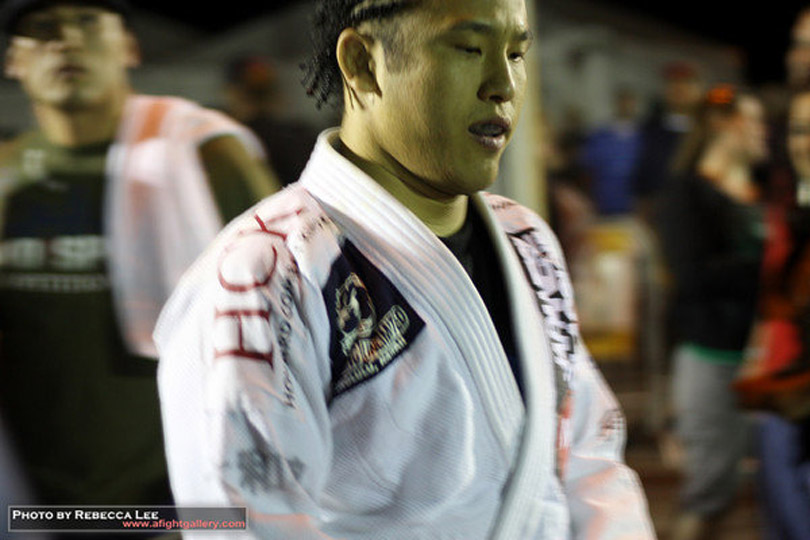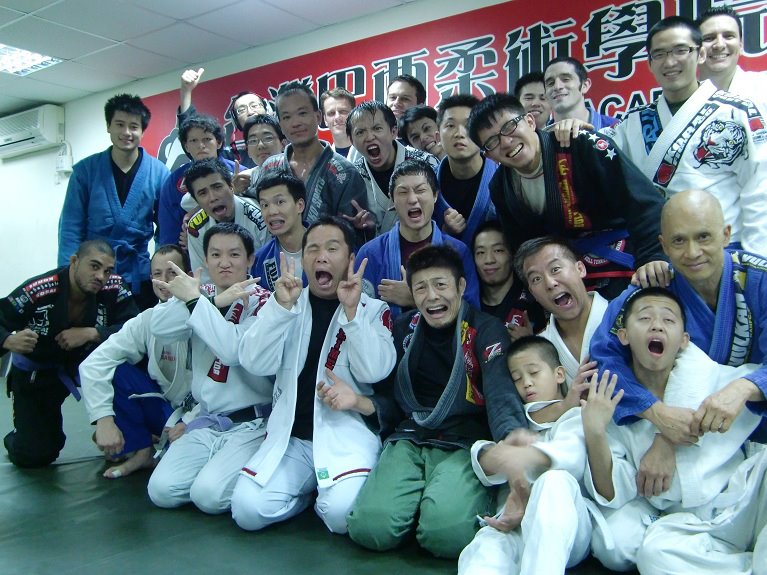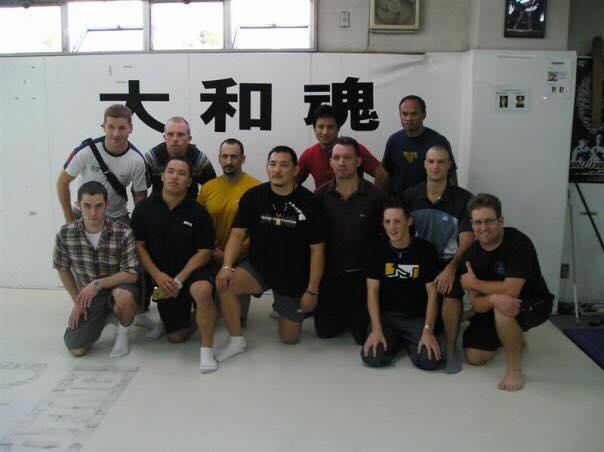Most people know about Andy Wang from his stint in TUF 5 with Nate Diaz, BJ Penn and Jens Pulver. But he is also a teacher. Like, a real, actual school teacher. He has degrees in both history and political science from the University of Hawaii at Manoa. Originally from Taiwan, his parents moved to the U.S. when he was a baby. He is a BJJ black belt under Egan Inoue, and has coached and trained extensively in Hawaii and Southern California. Now, he is based in Beijing, China and we managed to discuss what the BJJ and MMA scene is like in China.
BJJASIA – Can you kindly introduce yourself?
Andy Wang – My name is Andy Wang, I am currently residing in Beijing, China but I am originally from the United States and before that, Taiwan. I have been involved with Jiu-Jitsu since about 1996 and as the saying goes, time flies when you are having a good time and that definitely sums up my feelings about Jiu-Jitsu and MMA, especially when I first got started.
BJJASIA – How did you start training in BJJ?
Andy Wang – In 1995, my brother handed me a VHS videotape that more or less changed my life, although at the time I didn’t know it. I was still in high school and dreaming of what life in college was going to be like when my brother gave me a videotape with UFC 1-4 on it. I had heard very little about these events and thought it was fighting to the death and so as the video began to roll, I vividly recall taking a deep breath. Of course, the very first fight on the video was Gerard Gourdeau knocking out the Sumo fighter and after that I couldn’t stop watching the bouts.
Royce Gracie, of course, changed the way we all thought about fighting and I was very interested in his style of grappling. I was already wrestling in high school and the chokes and submissions of Jiu-Jitsu that I saw Royce doing on opponents a lot bigger than him was awe-inspiring. I started with Japanese Ju-Jitsu under Ron Thomas and to this day, it was one of the best martial arts experiences of my life. I was just a kid then but the training was hard and we practiced striking, throws and of course, ne-waza. After about a year training with Sensei Ron, I moved away from the San Fernando Valley and ended up at what was then the RCJ Machado Academy which was led by Rigan, Roger and John Machado.
It was an incredible experience as at that time, it was a hub for BJJ competitors and aspiring MMA fighters so each day was intense rolling with people from everywhere. Around that time, I was also going to school in Hawai’i and I was pleasantly surprised to find that a Gracie Academy was very close to where I was living and it was there that I trained under Relson Gracie and of course, met a young Baret Yoshida who took me under his wing.
Looking back on it now, I was very lucky and blessed to have such amazing instructors and training partners when I started out.
BJJASIA – Where did you begin MMA?
Andy Wang – Baret Yoshida was friends with Egan and Enson Inoue, who are both legends in the sport. Baret began training at Egan’s Grappling Unlimited dojo in Hawaii and brought me along. Originally, there was no plan on competing in MMA but Baret decided to go for it and I liked the idea of that challenge and jumped both feet in with him.For me, going from watching Egan fighting in the ring and then getting to train with him was an experience I will never forget. Egan was the most disciplined athlete I had ever
been around and his work ethic was incredible. At that time, Egan was fighting top fighters from all over the world and he made the Neal Blaisdell Arena in Honolulu the place to be on fight nights. It really was an incredible time and place to be as MMA was just starting in America and we were all there to experience and witness it.
Later on, I spent time training at the rAw/R1 training center with famed coach Rico Chiapparelli and his team of champions that included Frank Trigg, Vladimir Matyushenko, Fernando Vasconcellos and Mac Danzig. That was truly a house of champions and the caliber of athletes that came through there was incredible. Perhaps at a later date I can talk about training with Wallid Ismail there; the coolest, craziest,
toughest guy you’ll ever meet!
BJJASIA – What is the MMA scene in China like?
Andy Wang – When I first arrived in 2011, it seemed on the cusp of being the next region to take off on the world scene. There were MMA events all over China and events were happening monthly with high level local and international fighters. Of course, when Zhang Weili became the UFC champion and the UFC opened a Performance Institute in Shanghai, things really seemed to be moving forward. Obviously, the past few years were very difficult and it is starting up again with more events emerging and teams developing
local fighters but it is not at the level it was a few years ago.
BJJASIA – What brought you out to China?
Andy Wang – My good friend Gene Yu had a great idea to start an MMA apparel brand named, ‘Flow’. I was in Taiwan at the moment and had never been to Mainland China and he convinced me to come out and help him build up the brand. We went to Beijing and Shanghai and I was totally blown away with not only the grassroots training and events happening all over China but I was also deeply touched while visiting cities such as Nanjing, which is my father’s ancestral home. The moment I got to China, I had the feeling that I wanted to stay for a while. Twelve years later with a wife, daughter and dog and a boat load of memories and experiences, I am grateful for the opportunity of coming to China in 2011.
BJJASIA – In terms of competing Submission Grappling and Jiu-Jitsu what rule set do you favor the most and why?
Andy Wang – In 1999, the Gracie Academy in Torrance held a tournament that to most of us seemed pretty unorthodox and gnarly; no time limit, submission or first to 15 points would be the only way to win. It was a fascinating experience as most of us, of course, had never had matches longer than 5 or so minutes up to that time. Helio Gracie was there and it was an exciting event as it was the first time many of us would compete against Gracie Academy Torrance students, which still had a mystique with Rorion and Royce being the main instructors there.
I was a blue belt, very excited and then ended up having a match that was about an hour long against Mike Rose and many times during the match, I’m sure Mike and I both got distracted and started thinking about what was playing at the local movie theater that night. It was a good experience but it didn’t feel like combat; it was more of a rolling session. Of course, IBJJF-style has its limitations also (who doesn’t feel bad after giving up an advantage or a couple of points and then being stalled out on?) but to me, it
always feels like combat with a sense of urgency to score first and if being scored on, recovering as soon as possible as you know the time is counting down.
I don’t think there is a perfect rule set but to me, the IBJJF-style is closer to what I felt in MMA competition and that instinct of doing damage as soon as possible without taking damage is an important attitude and skill to hone, especially when it comes to self-defense applications. In the end, what I learned from Egan Inoue and Baret Yoshida by watching them train and compete in everything was that your Jiu-Jitsu should work everywhere; MMA, IBJJF, ADCC, etc. so we should all strive to learn and train and become adaptable to a variety of rule sets.
BJJASIA – You seem to have trained around the world? Tell us about your tenure in various
parts of Asia.
Andy Wang – Yes, it’s been a fascinating and interesting experience being able to visit several regions in Asia thanks to martial arts and meeting practitioners of many ethnicities, nations and cultures. My first trip was in 2004 to coach in Taiwan at what was then the beginnings of the Taiwan BJJ Academy.
Most of those original members are still practicing Jiu-Jitsu to this day and remain my close friends and it definitely got me more interested in traveling throughout Asia and gaining as much experience as possible on and off the mats. Believe it or not, I’m a social studies teacher and I’ve learned so much from visiting gyms and competitions, meeting people from all walks of life and sharing some sweat on the mats together.
BJJASIA – How do you find the training environment in Asia compared to other regions in the
world?
Andy Wang – America still has the best support and infrastructure for training and competing. All of the top coaches, athletes and competitions for Jiu-Jitsu call the U.S. home so of course over there you have exposure and opportunity to get top-notch training and seasoning. Asia currently has more and more events but as far as I know, there still has not been an IBJJF adult black belt world champion so there is a lot of work still to be done. I would also add that a crucial factor is that not only are the athletes more experienced in America, but so are the coaches and staff. Many teams in America now have strength & conditioning coaches and nutritionists specifically for BJJ and MMA athletes which makes such a difference at the elite levels.
BJJASIA – What is the most influential or biggest personal achievement in your career so far?
Andy Wang – Meeting Baret Yoshida when I was a white belt. He was the one that convinced and proved to me that grappling works. The first day I showed up at Relson Gracie Academy in Honolulu, Hawaii, Baret who was probably 130 lbs. and a blue belt back then, asked me to roll. Of course, I figured it would be easy work since I wrestled and weighed a lot more than him. He submitted me about 10 times in the first 10-15 minutes and I was in awe. I challenged him to roll again the next day and he submitted me 10 more times in about half the time. I was convinced. I trained with him daily for the next couple of years and the lessons were incredible. Around that time, he told me he was going to someday compete on the biggest stage against the best in the world. Twenty-some years later, with dedication and sheer willpower, he became an ADCC Hall of Fame competitor, multiple time world champion and household name in the grappling world.
Truly an inspiration.
BJJASIA – How would you evaluate the current trends in Jiu-Jitsu?
Andy Wang – The sport has grown tremendously, obviously, but with that comes the shrinking of the martial art. It’s the natural course of things, I suppose. As the martial art becomes more of a sport and mainstream, the priorities and goals change from learning to fight to learning to win a medal.
On the one hand, it’s great, you have ADCC going to the T-Mobile Arena next year which is fantastic and shows the growth and popularity the sport is heading towards but on the other hand, how many of these grappling gyms are practicing takedowns, striking, etc.? The popularity of grappling is terrific but at the same time, in my opinion, to call it ‘self-defense’ or ‘MMA’ is a bit misleading. It is a sport now with lots of rules and regulations and competitors who are specializing in those specific rules sets. I’ll go on the record and say that the Japanese Ju-Jitsu I learned at the beginning of my career was much better training for self-defense; BJJ is much better for grappling competition, obviously, but winning a tournament doesn’t mean you’re competent at self-defense.
My point is that all styles of grappling (i.e., Judo, Wrestling, BJJ, etc.) have its value and we should train in standing as well as ground techniques to be as well-rounded aspossible and effective martial artists.
BJJASIA – Lastly, is there anyone you would like to thank or shout out?
Andy Wang – Too many people and places to name just one, to be honest. But at this moment, I’d really like to thank Howard Liu, who was the founder of one of the best BJJ kimono and apparel brands, Howard Combat Kimonos. I met him at RCJ Machado when I was a white belt and he was a mentor to me on and off the mats and he was so supportive as a mentor and friend. We used to have talks that would go for hours at his warehouse in Gardena, California. I learned a lot from him on the mats but his unwavering kindness and support to me influenced how I coach and teach to this day.
As we all know, true friends are rare, and I am glad that Howard has been a true friend for the entirety of my martial arts journey, I really cannot thank him enough.












